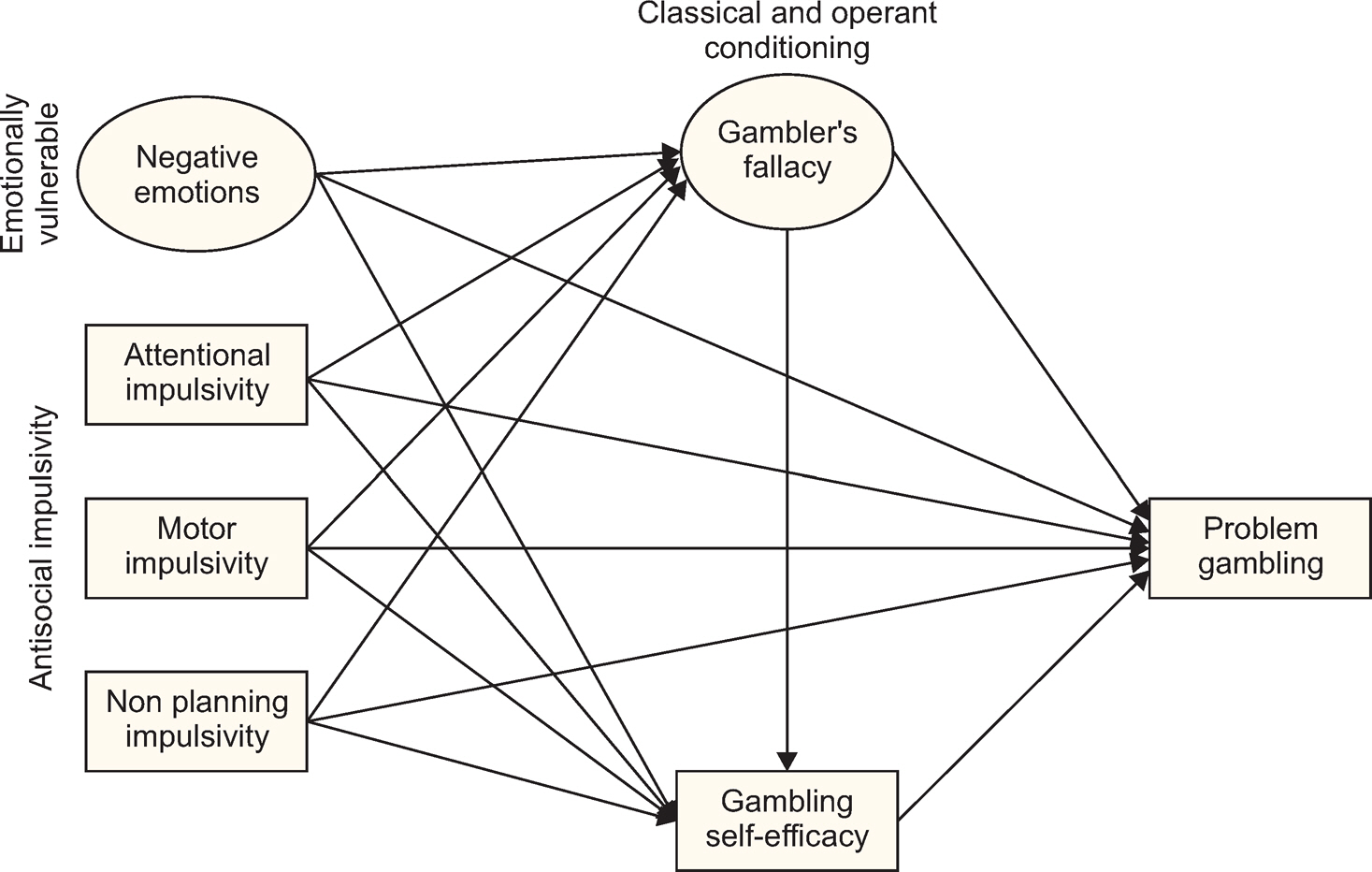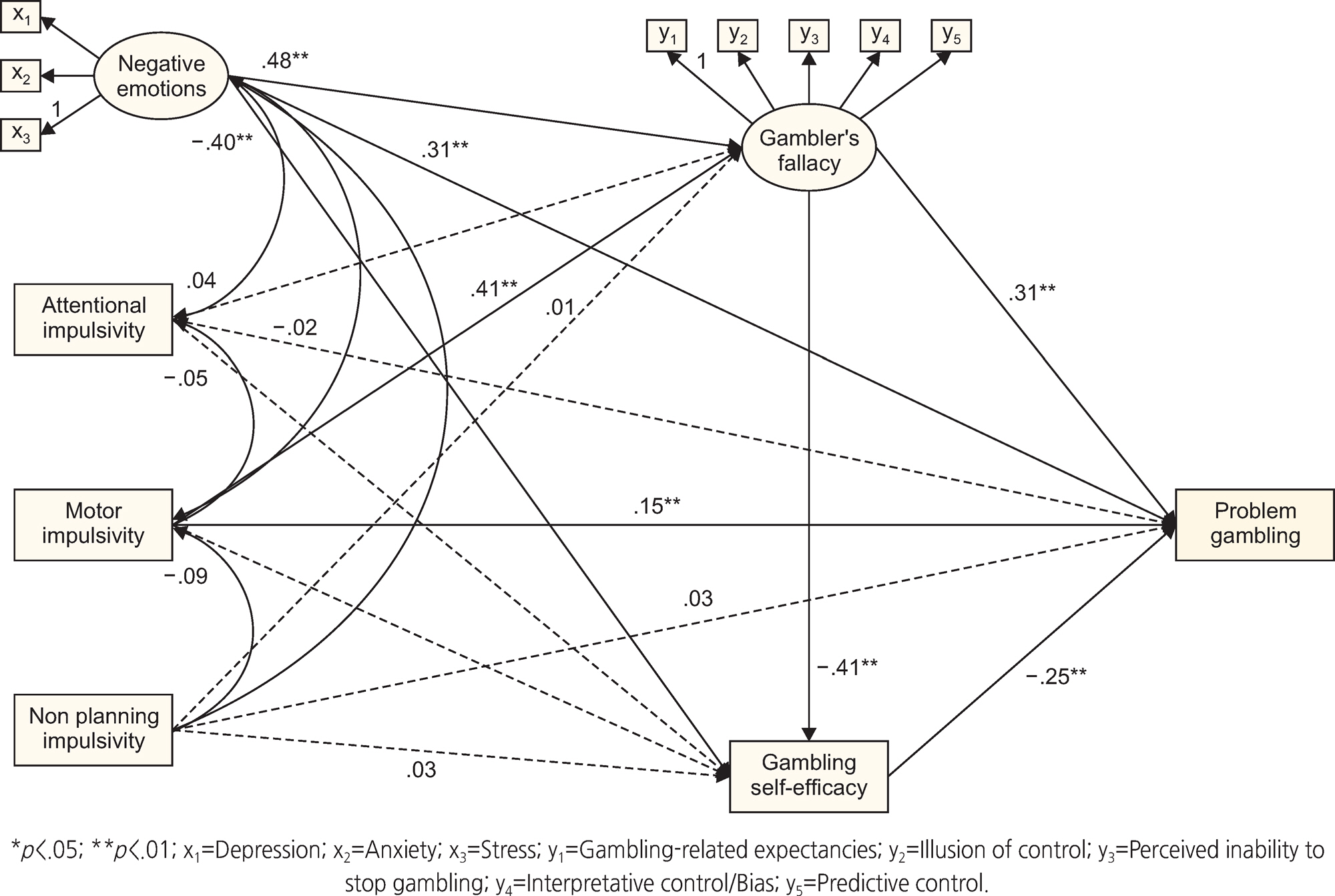J Korean Acad Nurs.
2018 Apr;48(2):195-207. 10.4040/jkan.2018.48.2.195.
Testing a Model to Predict Problem Gambling in Speculative Game Users
- Affiliations
-
- 1Department of Nursing, Chodang University, Muan, Korea.
- 2College of Nursing, Ewha Womans University, Seoul, Korea. suksunkim@ewha.ac.kr
- KMID: 2410652
- DOI: http://doi.org/10.4040/jkan.2018.48.2.195
Abstract
- PURPOSE
The purpose of the study was to develop and test a model for predicting problem gambling in speculative game users based on Blaszczynski and Nower's pathways model of problem and pathological gambling.
METHODS
The participants were 262 speculative game users recruited from seven speculative gambling places located in Seoul, Gangwon, and Gyeonggi, Korea. They completed a structured self-report questionnaire comprising measures of problem gambling, negative emotions, attentional impulsivity, motor impulsivity, non-planning impulsivity, gambler's fallacy, and gambling self-efficacy. Structural Equation Modeling was used to test the hypothesized model and to examine the direct and indirect effects on problem gambling in speculative game users using SPSS 22.0 and AMOS 20.0 programs.
RESULTS
The hypothetical research model provided a reasonable fit to the data. Negative emotions, motor impulsivity, gambler's fallacy, and gambling self-efficacy had direct effects on problem gambling in speculative game users, while indirect effects were reported for negative emotions, motor impulsivity, and gambler's fallacy. These predictors explained 75.2% problem gambling in speculative game users.
CONCLUSION
The findings suggest that developing intervention programs to reduce negative emotions, motor impulsivity, and gambler's fallacy, and to increase gambling self-efficacy in speculative game users are needed to prevent their problem gambling.
Figure
Reference
-
References
1. Ko JJ, Kwon SJ, Lee GO, Kim MJ, Jang EH. Survey on the use of gambling industry in2014. Health Hazard Evaluation Report. Seoul: The National Gambling Control Commission;2014. Oct. Report No.: 11-1371045-000042-11.2. Park BL, Kim MJ, Jang EH, Gwon SJ, Lee GO. A survey on the actual condition of the national gambling industry in 2016 [Internet]. Seoul: The National Gambling Control Commission;c2016. [cited 2018 Apr 10]. Available from:. http://www.ngcc.go.kr/data/pds.do.3. Lim SB, Park YJ. A study of gambling addiction determinant of university/college students and intervention for community. Journal of Community Welfare. 2013; 45:229–253.4. American Psychiatric Association. Diagnostic and statistical manual of mental disorders: DSM-5. 5th ed. Arlington (VA): American Psychiatric Publishing;2013. p. 584–590.5. Neal P, Delfabbro PH, O’Neill M. Problem gambling and harm: Towards a national definition [Internet]. Victoria: Gambling Research Australia;c2005. [cited 2018 Mar 31]. Available from:. https://trove.nla.gov.au/version/24739396.6. Sung JM, Kim JJ. A study on the risk and protective factors influencing addiction of gambling industry users at off-track betting place. Health and Social Welfare Review. 2014; 34(3):135–164. https://doi.org/10.15709/hswr.2014.34.3.135.7. Kennedy SH, Welsh BR, Fulton K, Soczynska JK, McIntyre RS, O’Donovan C, et al. Frequency and correlates of gambling problems in outpatients with major depressive disorder and bipolar disorder. The Canadian Journal of Psychiatry. 2010; 55(9):568–576. https://doi.org/10.1177/070674371005500905.
Article8. Park CH. A study on the soundness of gamble industry. Journal of Travel Study. 2008; 29:21–48.9. Chun JS, Kim SW, Chung IJ, Cho SM, Kim SM. Social and economic costs of gambling addiction in South Korea. Journal of Community Welfare. 2011; 39:129–154.10. Blaszczynski A, Nower L. A pathways model of problem and pathological gambling. Addiction. 2002; 97(5):487–499. https://doi.org/10.1046/j.1360-0443.2002.00015.x.
Article11. Jung JY, Hwang HK. Effects of impulsiveness on gambling addiction. The Korea Entertainment Industry Association;2016. 2016:p. 27–35.12. Kräplin A, Bühringer G, Oosterlaan J, van den Brink W, Goschke T, Goudriaan AE. Dimensions and disorder specificity of impulsivity in pathological gambling. Addictive Behaviors. 2014; 39(11):1646–1651. https://doi.org/10.1016/j.addbeh.2014.05.021.
Article13. Gupta R, Nower L, Derevensky JL, Blaszczynski A, Faregh N, Temcheff C. Problem gambling in adolescents: An examination of the pathways model. Journal of Gambling Studies. 2013; 29(3):575–588. https://doi.org/10.1007/s10899-012-9322-0.
Article14. Yoo CY, Kim EH. An explorative study of the pathways to problem gambling among college students: Focusing on social dysfunction and problem drinking. Journal of Social Science. 2014; 25(4):317–341. https://doi.org/10.16881/jss.2014.10.25.4.317.15. The National Gambling Control Commission of Korea. Survey on the gambling industry using state [Internet]. Seoul: The National Gambling Control Commission of Korea;c2014. [cited 2017 Nov 22]. Available from:. http://www.ngcc.go.kr/data/pds.do.16. Nordmyr J, Forsman AK, Wahlbeck K, Björkqvist K, Öster-man K. Associations between problem gambling, socio-demographics, mental health factors and gambling type: Sex differences among Finnish gamblers. International Gambling Studies. 2014; 14(1):39–52. https://doi.org/10.1080/14459795.2013.840328.
Article17. Lee KH, Do SL, Kim JN, Lee SM. A qualitative study of the process of gambling addiction. The Korean Journal of Health Psychology. 2011; 16(1):189–213.18. Kang SG, Kwon SJ, Kim KH, Rhee MK. Reliability and validity of the Korean version of the gambling urge scale. Korean Journal of Health Psychology. 2011; 16(1):231–241. https://doi.org/10.17315/kjhp.2011.16.1.014.19. Kim KH. The stage of change of problem gamblers for gambling abstinence, motivation for change of gambling abstinence, gambling cognitive errors, and gambling refusal self-efficacy [dissertation]. Gyeongsan: Daegu University;2013. p. 1–120.20. Jo WY. The effects of college students’ sport value on sport gambling perception and addiction. Journal of Sport and Leisure Studies. 2014; 57(1):651–660.
Article21. Michalczuk R, Bowden-Jones H, Verdejo-Garcia A, Clark L. Impulsivity and cognitive distortions in pathological gamblers attending the UK National Problem Gambling Clinic: A preliminary report. Psychological Medicine. 2011; 41(12):2625–2635. https://doi.org/10.1017/S003329171100095X.
Article22. Raylu N, Oei TP. The Gambling Related Cognitions Scale (GRCS): Development, confirmatory factor validation and psychometric properties. Addiction. 2004; 99(6):757–769. https://doi.org/10.1111/j.1360-0443.2004.00753.x.
Article23. Lee JI, Kwon JH. Effects of mindfulness based cognitive therapy on recovery of gambling addicts: A case study. Cognitive Behavior Therapy in Korea. 2015; 15(1):1–28.24. Oei TPS, Raylu N, Casey LM. Effectiveness of group and individual formats of a combined motivational interviewing and cognitive behavioral treatment program for problem gambling: A randomized controlled trial. Behavioural and Cognitive Psychotherapy. 2010; 38(2):233–238. https://doi.org/10.1017/S1352465809990701.
Article25. Yang JN, Choi EJ, Kim HS. A study on factors affecting problem gambling among adults in Korea. Mental Health and Social Work. 2011; 39:185–213.26. Lim SB. A study on gambling addiction factors of university/ college students: Based on mediating effect of gambling motivation, self-efficacy, and self-regulation. Health and Social Welfare Review. 2013; 33(2):489–524. https://doi.org/10.15709/hswr.2013.33.2.489.27. May RK, Whelan JP, Steenbergh TA, Meyers AW. The gambling self-efficacy questionnaire: An initial psychometric evaluation. Journal of Gambling Studies. 2003; 19(4):339–357. https://doi.org/10.1023/A:1026379125116.28. Jung SY. The structural model of college students’ gambling behavior [dissertation]. Daegu: Daegu Catholic University;2011. p. 1–80.29. Nower L, Gupta R, Blaszczynski A, Derevensky J. Suicidality and depression among youth gamblers: A preliminary examination of three studies. International Gambling Studies. 2004; 4(1):69–80. https://doi.org/10.1080/1445979042000224412.
Article30. Lee HP. The effect of irrational gambling belief to the pathological gambling. The Korean Journal of Clinical Psychology. 2003; 22(2):415–434.31. MacKay TL, Hodgins DC. Cognitive distortions as a problem gambling risk factor in Internet gambling. International Gambling Studies. 2012; 12(2):163–175. https://doi.org/10.1080/14459795.2011.648652.
Article32. Holdsworth L, Haw J, Hing N. The temporal sequencing of problem gambling and comorbid disorders. International Journal of Mental Health Addiction. 2012; 10(2):197–209. https://doi.org/10.1007/s11469-011-9324-7.
Article33. Dussault F, Brendgen M, Vitaro F, Wanner B, Tremblay RE. Longitudinal links between impulsivity, gambling problems and depressive symptoms: A transactional model from adolescence to early adulthood. Journal of Child Psychology and Psychiatry. 2011; 52(2):130–138. https://doi.org/10.1111/j.1469-7610.2010.02313.x.
Article34. Jackson AC, Francis KL, Byrne G, Christensen DR. Leisure substitution and problem gambling: Report of a proof of concept group intervention. International Journal of Mental Health Addition. 2013; 11(1):64–74. https://doi.org/10.1007/s11469-012-9399-9.
Article35. Lee HW, Choi JS, Shin YC, Lee JY, Jung HY, Kwon JS. Impulsivity in internet addiction: A comparison with pathological gambling. Cyberpsychology, Behavior, and Social Networking. 2012; 15(7):373–377. https://doi.org/10.1089/cyber.2012.0063.
Article36. Tang CS, Wu AMS. Direct and indirect influences of fate control belief, gambling expectancy bias, and self-efficacy on problem gambling and negative mood among Chinese college students: A multiple mediation analysis. Journal of Gambling Studies. 2010; 26(4):533–543. https://doi.org/10.1007/s10899-010-9177-1.
Article37. Bergen AE, Newby-Clark IR, Brown A. Gambling increases self-control strength in problem gamblers. Journal of Gambling Studies. 2014; 30(1):153–162. https://doi.org/10.1007/s10899-012-9350-9.
Article38. Son SM, Yi IH. The relationship of irrational belief, deficit of decision making and gambling problem. Clinical Psychology in Korea: Research and Practice. 2016; 2(1):39–57.39. Blinne-Pike L, Worthy SL, Jonkman JN. Adolescent gambling: A review of an emerging field of research. Journal of Adolescent Health. 2010; 47(3):223–236. https://doi.org/10.1016/j.jadohealth.2010.05.003.
Article40. Park HS, Jung SY. Structural analysis of low level gambling behavior in college students. Journal of Academy of Psychiatric and Mental Health Nursing. 2015; 24(4):267–278. https://doi.org/10.12934/jkpmhn.2015.24.4.267.
Article41. Lee HR, Doh HS, Kim MJ, Park BK. Pathways from maternal parenting behavior to adolescents’ internet addiction: Mediating effects of adolescents’ self-control and depression/anxiety. Korean Journal of Child Studies. 2009; 30(2):97–112.42. Lindberg A, Fernie BA, Spada MM. Metacognitions in problem gambling. Journal of Gambling Studies. 2011; 27(1):73–81. https://doi.org/10.1007/s10899-010-9193-1.
Article43. Woo JP. Jongpill’s concept and understanding of structural equation model. Seoul: Hannarae Publishing Co.;2012. p. 1–568.44. Ferris J, Wynne H. The Canadian problem gambling index: Final report. Ottawa: Canadian Centre on Substance Abuse;2001. p. 1–59.45. Kim AY, Cha JE, Kwon SJ, Lee SM. Construction and validation of Korean version of CPGI. Korean Journal of Psychology: General. 2011; 30(4):1011–1038.46. Lovibond PF, Lovibond SH. The structure of negative emotional states: Comparison of the Depression Anxiety Stress Scales (DASS) with the beck depression and anxiety inventories. Behaviour Research and Therapy. 1995; 33(3):335–343. https://doi.org/10.1016/0005-7967(94)00075-U.
Article47. Cha ES, Park MY, Kim GA. A comparison analysis of somatotype, physical activity, mental health, healthy behavior between normal weight and overweight college students in Korea. Korean Journal of Health Promotion. 2008; 8(4):245–255.48. Patton JH, Stanford MS, Barratt ES. Factor structure of the Barratt impulsiveness scale. Journal of Clinical Psychology. 1995; 51(6):768–774. https://doi.org/10.1002/1097-4679(199511)51:6<768::AID-JCLP2270510607>3.0.CO;2-1.
Article49. Heo SY, Oh JY, Kim JH. The Korean version of the Barratt impulsiveness scale, 11th version: Its reliability and validity. The Korean Journal of Pyschology: General. 2012; 31(3):769–782.50. Kim JY. Identifying factors affecting the recovery of patho-lolgical gamblers [dissertation]. Daegu: Kyungpook National University;2005. p. 1–186.
- Full Text Links
- Actions
-
Cited
- CITED
-
- Close
- Share
- Similar articles
-
- Testing an Explanatory Model for Preventing College Students' Problem Gambling
- The Trajectory of Loneliness among Adolescent Game Players
- Online Gambling Patterns and Predictors of Problem Gambling Among Korean Adolescents During the COVID-19 Pandemic: A Cross-sectional Study
- A Differential Equation Model for the Dynamics of Youth Gambling
- Relationships Between Adult Attention Deficit Hyperactivity Disorder Symptoms and Problem/Pathological Gambling



